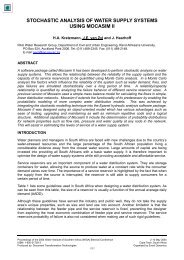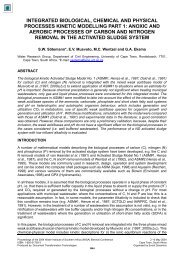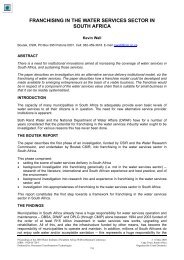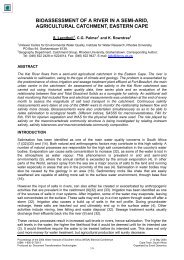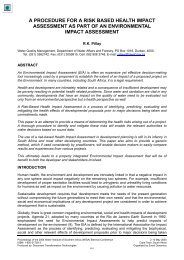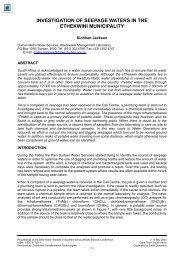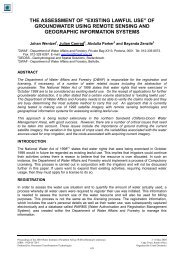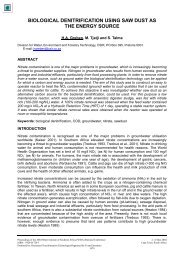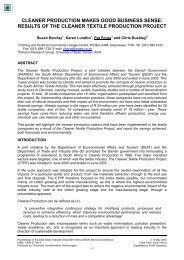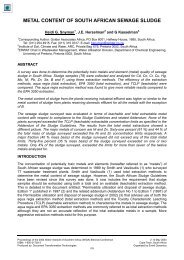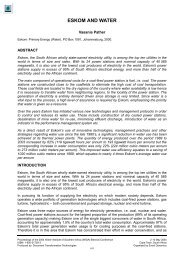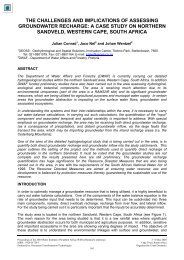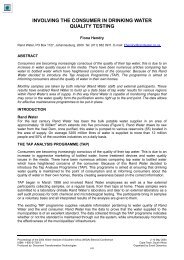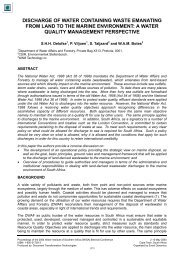eBook (pdf) - eWISA
eBook (pdf) - eWISA
eBook (pdf) - eWISA
You also want an ePaper? Increase the reach of your titles
YUMPU automatically turns print PDFs into web optimized ePapers that Google loves.
<strong>eWISA</strong> Water History<br />
1500 - 1799
1500-1510<br />
1512: Water supply to ships in Mossel Bay. Dias named the fresh-water spring "Aguada de<br />
São Bras" (watering place of St Blaize). In 1512, Gaspar Correa, described it as flowing over a<br />
rocky verge into a small dam. The spring still flows today.<br />
1510-1520<br />
1520-1530<br />
1530-1540<br />
1540-1550<br />
1550-1560<br />
1560-1570<br />
1570-1580<br />
1580-1590<br />
1590-1599<br />
<strong>eWISA</strong> Water History<br />
16 th<br />
Century
1600-1609<br />
1610-1619<br />
1620-1629<br />
1630-1639<br />
1640-1649<br />
1663: The survivors of the Haarlem, wrecked in Table Bay in 1648 recommended that a<br />
victualling station be set up there. The weight of their recommendations is not clear, but<br />
nevertheless the governing board of the Dutch East India Company, usually referred to as the<br />
VOC, resolved to set up a temporary settlement at the foot of Table Mountain. This location was<br />
preferred to the safer harbour at Saldanha because of the abundant fresh water running off the<br />
slopes of Table Mountain<br />
1650-1659<br />
<strong>eWISA</strong> Water History<br />
17 th<br />
1652: Van Riebeeck established a VOC victualling<br />
station in Table Bay, main water supply is Platteklip<br />
Stream<br />
1655: First environmental 'legislation' - aimed at<br />
protecting water supplies from human fouling<br />
Century<br />
1655: When man arrives pollution follows. In 1655 van Riebeeck received a complaint from<br />
the VOC that the crew of a ship had been made ill by water taken in at the Cape. This was a<br />
serious indictment, not only on van Riebeeck's competency, but also of the suitability of the Cape<br />
as a victualling station – there was competition from St Helena. He immediately issued a<br />
"plakkaat" - the first South African environmental legislation - to prevent pollution of the water<br />
source:<br />
"Nobody shall turn sheep into the water, nor wash, nor stir<br />
up the water above the flow of the beck and fountain<br />
where the ships draw water, neither shall anyone dam or<br />
divert the water. People may wash only at the proper place<br />
on the east side of the moat of the Fort. They may not keep<br />
geese nor allow them to swim there. Nobody may cross the<br />
water furrow between the Fort and the Mountain with<br />
wagon, cattle, or merely in person other than by the usual<br />
places and bridges." And significantly: "Everyone of the<br />
inhabitants shall clear away the mess dirt and dung heaps<br />
in front of their houses".
1660-1669<br />
1660: In 1660 van Riebeeck widened and deepened<br />
the furrow, which now assumed the status of "canal" and<br />
he built a dam for filling water casks near the jetty in<br />
Cape Town harbour.<br />
1663: Zachariah Wagenaar (settlement commander)<br />
had a reservoir built in Cape Town for supply of water to<br />
ships (Golden Acre - can still be seen at the lower level<br />
of the arcade after restoration). This reservoir was 45 m<br />
long and 15 m wide.<br />
1670-1679<br />
1670: A stone water course from the Wagenaar Reservoir was constructed to the jetty (to<br />
supply ships with water) by Commander Jacob Borghorst, repacing the manual transporting of<br />
water in barrels.<br />
1680-1689<br />
1687: Wooden pipes (made of Burmese teak, because local timber was unsuitable) were<br />
introduced to supply water to and from reservoirs in Cape Town (Simon van der Stel was<br />
involved). These "pipes" were actually "bored trees".<br />
1689: Izaak Schryver camped next to a river where he encountered so many doves, he called<br />
the river Duivenhok (Dovecote).<br />
1690-1699<br />
Jan Van Riebeeck Dam – Dept. Water<br />
Affairs and Forestry
1693: In 1693 Simon van der Stel promoted the Superintendent of the Company's garden,<br />
Hendrik Oldenland, to be the first Town Engineer of Cape Town. The Governor and his<br />
technical assistant embarked on a series of engineering works, including improvements to the<br />
Heerengracht and the Kaisersgracht which ran along the line of the present Darling Street,<br />
bringing additional water to the Castle and linking the Heerengracht system to the Capelsluit.<br />
Although van Riebeeck had named the main stream the "Varsche River" it soon became a<br />
polluted drainage path.
1700-1709<br />
1707: In 1707 Willem Adriaan van der Stel procured 200 lead pipes from the VOC to bring<br />
fresh water from the foot of Table Mountain to the jetty; a four-jet fountain supplied the local<br />
needs, and Cape Town was, waterwise, considered to be well provided for. Water for household<br />
use was taken from the canals which ran alongside the streets while the well in Greenmarket<br />
Square was the main source of water when the channels were dry.<br />
1710-1719<br />
1720-1729<br />
1730-1739<br />
1731: Initially the Dutch did not intend to establish more than a provisioning station at the Cape,<br />
and although this policy was later modified, Cape Town remained a "company town" and growth<br />
was slow. The Free Burghers who farmed on their own behalf on the outskirts of the city were<br />
controlled by very restrictive conditions, and the Directors of the Company, the "Here Sewentien"<br />
were very reluctant to spend any money on "unnecessary" infrastructure. Initially this attitude was<br />
determined by greed and the profit motive; in the latter stages of the VOC's administration the<br />
company was approaching bankruptcy and simply had no funds to spend. The grip of the VOC<br />
weakened as it declined and the private citizenry increased. By 1731 the population was 3,157,<br />
of whom a third were company employees. The town was growing, and the grid pattern<br />
established by van Riebeeck was extended. The streets continued to be flanked by channels<br />
which were both a source of water supply and a means of drainage.<br />
1740-1749<br />
1750-1759<br />
1760-1769<br />
1770-1779<br />
<strong>eWISA</strong> Water History<br />
18 th<br />
Century<br />
1770: Fresh water from the foot of Table Mountain (i.e Platteklip steam) to the jetty Buitengraght<br />
canal established.
1771: In 1771 the Buitengracht canal (in Cape Town) was established to act as a cut-off drain for<br />
the runoff from Signal Hill, and desultory attempts were made to install drainage in the main<br />
streets. The Council voiced concern about the deteriorating state of the grachts.<br />
1773: Uitenhage Springs: The Springs lie in pristine surroundings between the hills of<br />
sandstone at the foot of the Great Winterhoek Mountains and are located 8 km north of the town<br />
centre. The artesian water flows from the ground at nine eyes. The first burgher to farm in the<br />
Springs area was a Mr C Viljoen who obtained a permit in September 1773 on the farm<br />
Sandfontein. Viljoen was the brother-in-law of Gerrit Scheepers. He later dammed the water from<br />
the Springs which cut off the water to Scheepers’ farm. The two quarreled resulting in ill-feeling.<br />
Viljoen then sold his farm to Christoffel Kock, who was married to Scheepers’ daughter, Sara<br />
Johanna. A few kilometres from the Uitenhage Springs are the Amanzi Springs, which are used for<br />
commercial irrigation. Bifaces, a collective name for stone tools used in the Stone Age, have been<br />
found at Amanzi and are at least 250 000 years old.<br />
1780-1789<br />
1790-1799
1. .Bartolomeu Dias Museum. Mossel Bay<br />
2. .Woodhead Dam. 100 years. Centenary. City of Cape Town. ISBN 1-874924-<br />
72-4<br />
3. Tony Murray. History of Rivers and Drainage in the Cape Metropolitan<br />
Area.<br />
4. Timeline: Water Supply to the City: The first 300 years – circa<br />
5. Raymer, David Anthony. A HISTORY OF PORT ELIZABETH AND<br />
UITENHAGE’S WATER SUPPLY. Raymer, David Anthony, civil engineer.<br />
Employed as graduate engineer in July 1980. Promoted to Assistant Water<br />
Engineer in 1988 and Water Engineer (Operations) in 1990. Appointed<br />
Assistant Manager (Bulk Water & Water Management) in 2004. Resigned in<br />
February 2007 to work for consultants. He is the author of the book, Streams<br />
of Life: A History of Port Elizabeth and Uitenhage’s Water Supply. * Port<br />
Elizabeth 22.8.1953<br />
6. Institute for Municipal Engineering in South Africa.<br />
(http://imesa.vdw.co.za/AM/Template.cfm?Section=History&Template=/C<br />
M/HTMLDisplay.cfm&ContentID=1479)<br />
7. Wide Blue<br />
8. Water, Water, everywhere...<br />
(http://www.joburg.org.za/2004/dec/dec24_water.stm)<br />
9. Scanned document "THE HISTORY OF WATER SUPPLY TO PRETORIA"<br />
received from Mr.Koot Snyman of City of Tshwane.<br />
10. Grobler, Roger R. (1996). A Framework for Modelling Losses arising from<br />
Natural Catastrophes in South Africa. University of Pretoria.<br />
11. Grant, George & Flinn, Taffy (1992). Watershed Town. The History of the<br />
Johannesburg City Engineer's Department.<br />
12. Table Mountain<br />
<strong>eWISA</strong> Water History<br />
References<br />
13. Management of the WATER RESOURCES of the Replubic of SOUTH<br />
AFRICA. The Department of Water Affairs. 1986.<br />
14. Department of Water Affairs and Forestry - Sterkfontein Dam (<br />
http://www.dwaf.gov.za/orange/Vaal/sterkfon.htm )<br />
15. WISA: PAST AND PRESENT (Acknowledgement: The idea for this started<br />
while chatting with Eric Hall, who also started the ball rolling with some of<br />
his memories. The bulk of what is contained here is the work of Dave
Osborne - also known as the "father" of WISA - who painstakingly<br />
researched the issue, and to whom we are deeply indepted)<br />
16. Scanned document "Sewerage reticulation and waste water treatment"<br />
received from Mr.Koot Snyman of City of Tshwane.<br />
17. Information by e-mail: DARRYL MOSS. General Manager - Mining<br />
Distribution. Metso Minerals. E-mail: darryl.moss@metso.com<br />
18. Rand Water Corporate Profile<br />
19. On route in South Africa - BPJ Erasmus
This e-book may be copied and distributed to others, but may not<br />
be sold. This e-book must be fully referenced wherever it may be<br />
used.<br />
Copyright ©WAMTechnology CC. All Rights Reserved



